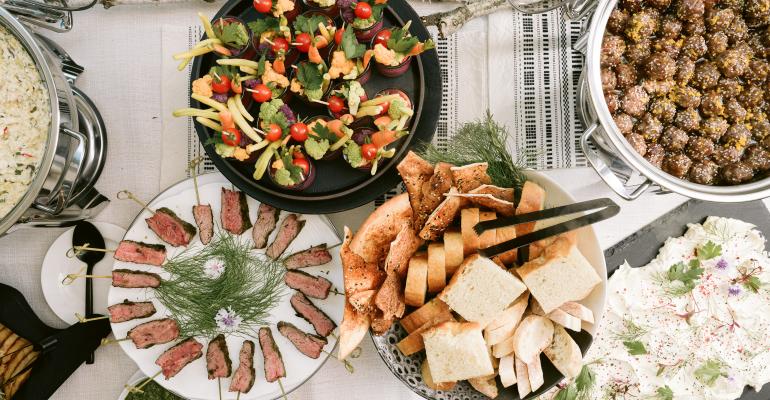There’s nothing more refreshing than a change in season, and the menu for your event is a great place to reflect those changes.
Seasonality is the concept of being dependent on the season or time of year. It’s easy to think of a fall festival or winter wonderland-type event whose purpose is to celebrate the season, but any event can feature a little ode to the phases of nature.
This means featuring food that is harvested at its peak rather than prematurely, and it relies on sourcing in-season food from local farms and suppliers instead of transporting over long distances when out of season. For example, in the Midwest, tomatoes can only be grown and harvested from outdoor farms during mid to late summer. In the winter, Midwesterners can eat tomatoes, but these crops must be shipped in from places whose climates support tomato growth in the winter months, which often are picked prematurely, resulting in pale, flavorless tomatoes instead of the brightly colored, richly flavored fruit they can be.
As a planner, you can bring seasonality to any event by working with your clients and caterer to create a dining experience grounded in the seasons, with ingredients, dishes, and beverages that complement the time of year.
Making the world go ‘round
Seasonality isn’t just a fun theme to try out or a trend to hop on. This practice is actually beneficial in a variety of ways.
For starters, working with the seasons is financially practical, because sourcing local ingredients is an investment into the local economy. Seasonal ingredients are also less expensive, since all the same items are harvested and sold during the same time window, creating a huge supply with decreased prices.
In an article on sustainability for Catersource magazine, Clint Elkins (SB Value) quotes Matt Haggerty (DSquared Catering, Seattle) on the price of in-season items: “Typically, seasonal ingredients are more available so they can be cheaper or easier to find. We currently change our menus four times a year to reflect the season and allow for purchasing power.”
Sarah Kuhlberg (Colette’s Catering & Events, Orange County, CA) agrees. “It is important to think about variety and innovation, as eating seasonally encourages diversity in menu options throughout the year,” she told Special Events. “This can be exciting for clients and their guests. Inform clients that each season offers its own set of ingredients, allowing for innovative and creative menu planning. Also, seasonal ingredients are usually more abundant and cost-effective. Inform clients that choosing seasonal items can help manage costs while still providing high-quality meals. Caterers can work within budget constraints more effectively this way as well.”
Seasonal items also mean higher quality, especially with produce. When plants can be harvested at their prime and utilized nearly immediately—versus harvesting early, transporting across long distances, and ripening artificially or in stores—they retain freshness and even more nutrients than their off-season counterparts. And on farms where animals are fed fresh, high-nutrition plants that are in season, the flavor of the meat tastes better.
Working within the framework of the seasons also has social and environmental benefits, too. When you posit yourself within a network of people in the food system, it’s easy to see how many people and places are involved in getting food from the earth to your clients. Instead of working with caterers who use mass-produced food products that remove the visibility of a food item’s life cycle, you can form relationships with caterers and local growers and suppliers to create a community where you know exactly where every morsel your clients eat comes from.
“Skip the shipping and handling surcharges and take advantage of your local food scene, including butchers, farmers, beekeepers, brewers, and other specialists,” says Elkins. (Click here to read about caterers who are removing the middleman and working directly with ingredients at their conception.)
Seasonal, local ingredients also influence cuisine types that can play into personalizing your client’s menu. “Highlighting local cuisine with seasonal menus often reflects regional specialties,” says Kuhlberg. “Encourage your clients to explore local ingredients, which can add a unique and authentic touch to their event. Caterers can create menus that celebrate the area's culinary heritage.”
Finally, the environmentally sustainable benefits of seasonal menus can’t be overlooked. Sourcing local food means cutting out long-distance transportation, which greatly reduces greenhouse gas emissions. Local food sourcing also means you can guarantee you’re investing in food suppliers who participate in sustainable and regenerative practices.
“It's important to consider environmental responsibility, as eating seasonally aligns with sustainable practices,” says Kuhlberg. “Explain to clients that choosing seasonal foods reduces the carbon footprint and supports local farmers. Many clients value this eco-friendly approach.”
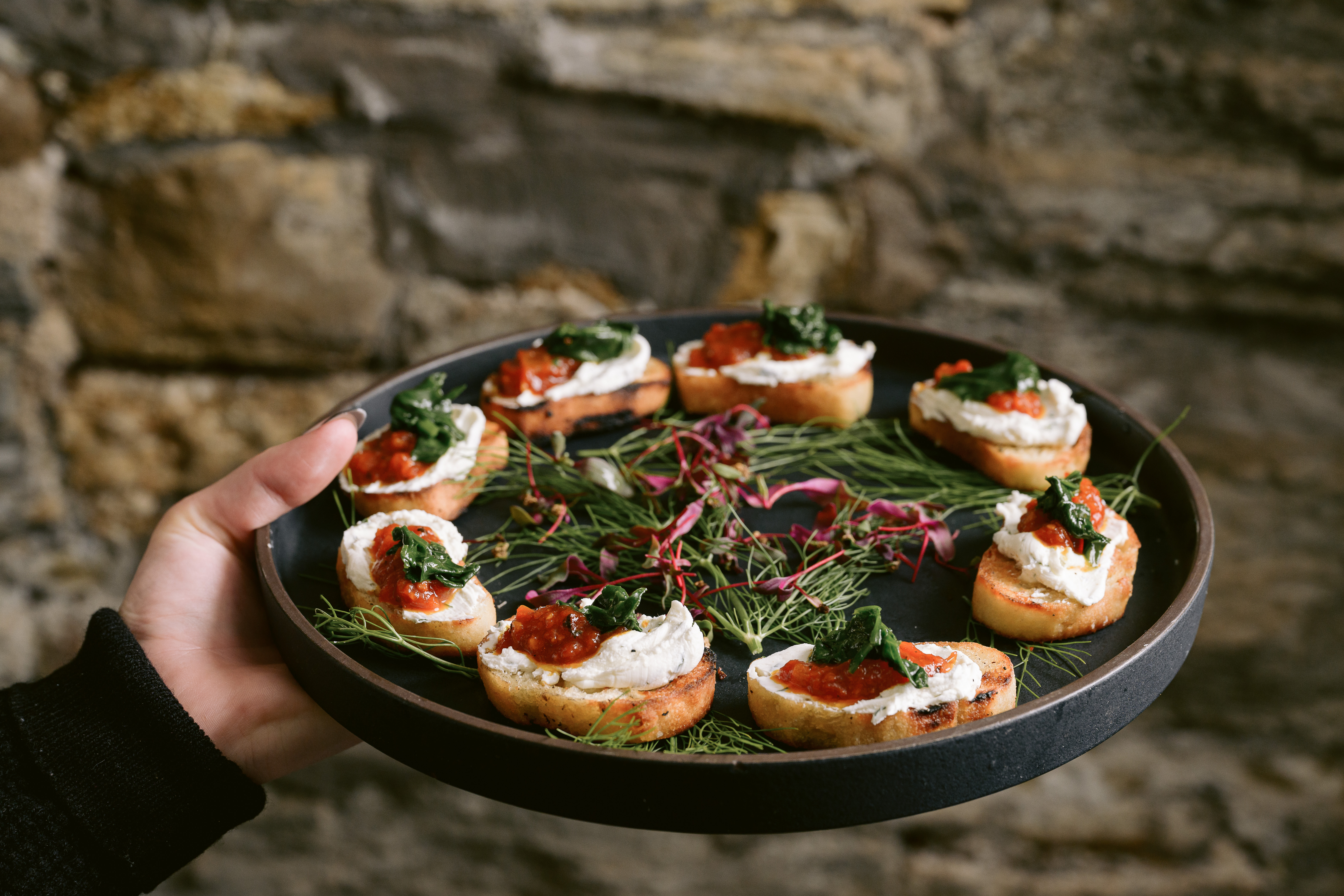
Chowgirls Catering offers Crostinis with Seasonal Toppings: at a tasting event in August, the topping was Saffron Tomato Jam & Chevre (whipped chèvre, saffron tomato jam, and sautéed organic spinach). Photo courtesy Lucas Botz
The secret ingredients
Many caterers already work within the seasons whether they advertise it or not, but if you aren’t sure, ask your preferred catering partners about where they source food from. You can also partner with caterers who prioritize seasonal menus.
In another article for Catersource magazine, Elkins notes that the key to seasonal is indeed sourcing local. “Embracing seasonality in your menu is best achieved through sourcing ingredients locally. By prioritizing local sourcing, you can ensure you're working with the freshest foods in your region. And since your location plays a significant role in determining what is ‘in season,’ it’s essential to curate a menu with dishes that feature local produce and meats.”
A knowledgeable caterer will know exactly what ingredients are in season and create a menu around nature’s offerings.
One example of this is Minneapolis-based Chowgirls Catering, who offers seasonal menus, upholding in-season items as the backbone of their catering approach.
Among one of the first “green” caterers in Minnesota, Chowgirls offers a menu for each season. “Many items on our menu are available year-round but feature different seasonal ingredients,” says Mandy Heathcote-Curry, an event specialist for Chowgirls. “For example, our Organic Vegetable Platter is on our menu in all seasons but it features different vegetables depending on the season.
“We do have a couple items that purposefully indicate ‘seasonal’ ingredients, such as our Crostini with Seasonal Toppings, which allows us to use ingredients we have in house and that helps us to avoid food waste,” Heathcote-Curry adds.
“Of course, sourcing locally means you’ll need to familiarize yourself with seasonal availability in your region and plan your menus accordingly,” says Elkins. “It might mean your strawberry cobbler becomes a rhubarb cobbler in the [spring], but the benefits of seasonal menus are worth the flexibility.”
Chowgirls’ menus do this by offering mini quiches all year round, with seasonal veggies and local cheese. Dishes like pies and galettes that can be filled with whatever is in season are easy ways to highlight seasonal ingredients, too.
The Chowgirls website also provides a calendar of what is in season at any given point in the year. You’ll see things like asparagus, peas, and ramps in the spring versus beets, Brussels sprouts, and winter squash in fall. They also make note of what to avoid: summer squash and tomatoes in spring, for instance, and asparagus and corn on the cob in fall.
Meat and seafood can also be featured based on seasonality.
In an article for the Huffington Post, Terry Ragasa of Sutter Meats explains how the symbiosis of animals and plants is affected by the seasons. “Before refrigeration, people would slaughter hogs around fall because they were eating apples and acorns that would fall on the ground. They'd let them hang over the winter, hams would be ready by Easter. But now, pigs are pretty hearty, farmers have them in and out and they can be eaten anytime. But there is a different flavor in the meat depending on the season."
Kuhlberg notes that seasonality looks a little different with meat than with produce. “While the concept of ‘seasonality’ might not apply to meats in the same way it does to fruits and vegetables, there are still some factors to consider when it comes to the availability and optimal times to serve different types of meat. At Colette’s Catering & Events, we always look to local farms and purveyors when it comes to seasonality and availability.”
Robin Selden (Marcia Selden Catering & Events and Naked Fig Catering) says that meat’s seasonality depends more on the type of meat and how it’s prepared. “What we find is that during the warmer months, our clients like to eat lighter meals that don’t include heavy meats. We also see that as the late fall and early winter approach, our clients are craving the heartier and heavier, saucier meats, like short ribs.”
Kuhlberg agrees. “While beef is available year-round, hearty and rich cuts like roasts and short ribs are often associated with the cooler months. Grilling cuts like steaks and burgers are typically popular during the warmer months.” The same goes for chicken.
Certain meats are most popular in spring. “Pork, including ham, doesn't have a distinct ‘season’; however, ham is often associated with spring,” she says. “Spring lamb is a term used to describe young lamb that is available in the spring months, usually March to May.” However, “lamb cuts can still be enjoyed year-round, with heartier preparations like stews being more common in the colder months.”
Seafood is more affected by seasonality than livestock, says Kuhlberg. “Seafood can be influenced by both seasonality and sustainability. Certain types of seafood, like shellfish and certain fish species, have peak seasons when they are most abundant and flavorful. It's also crucial to consider sustainable seafood practices and make choices that support responsible fishing and aquaculture.”
Flavors of the seasons
Seasonal menus also dial into the different associations and cravings of each time of year. While the seasons certainly differ depending on location, Kuhlberg and Selden share their favorites for each of nature’s turns.
Spring
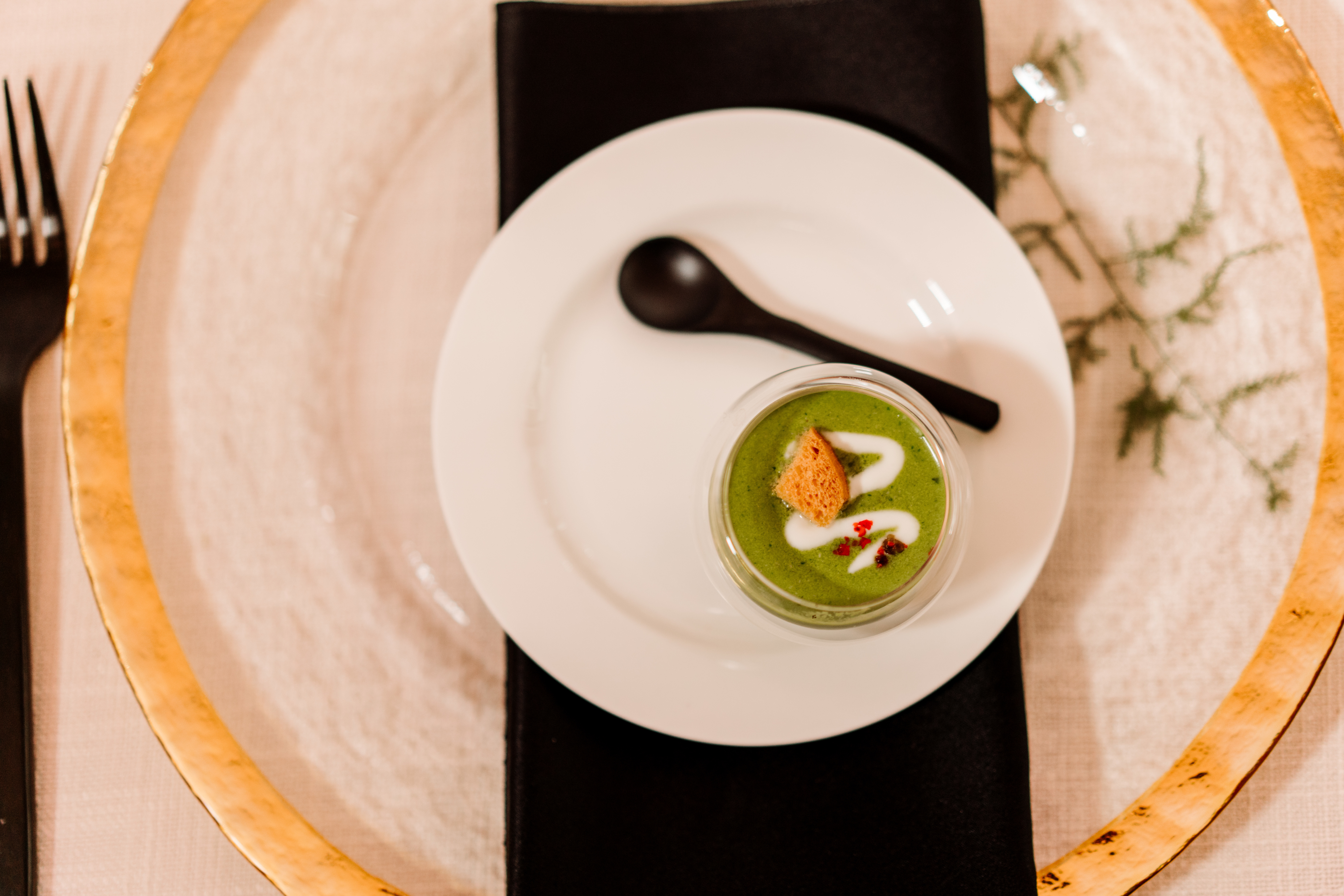
In the spirit of spring, Chowgirls Catering makes a green gazpacho, offered April through June. Photo courtesy Becca Dilley
“In springtime, I suggest offering dishes that are light and fresh,” says Kuhlberg. “Consider favorites like lemon herb chicken and salads that feature those crisp spring greens and juicy strawberries. Add a pop of seasonal joy with peas, radishes, and fragrant herbs.”
Another green to include is asparagus, which is “just so perfect when in season and can be used in so many ways, from a decadent asparagus risotto or even just grilled to perfection,” says Selden. “I also love to shave them into a salad.”
As for spring beverages, think light, fruity, and floral: Selden recommends beverages like Aperol spritzes, mojitos, gin and elderflower or cucumber cocktails, lemonade, and iced tea.
“Consider serving up sparkling rosé, spa water infused with fresh fruit, and elegant floral cocktails like elderflower spritzers,” suggests Kuhlberg.
Summer
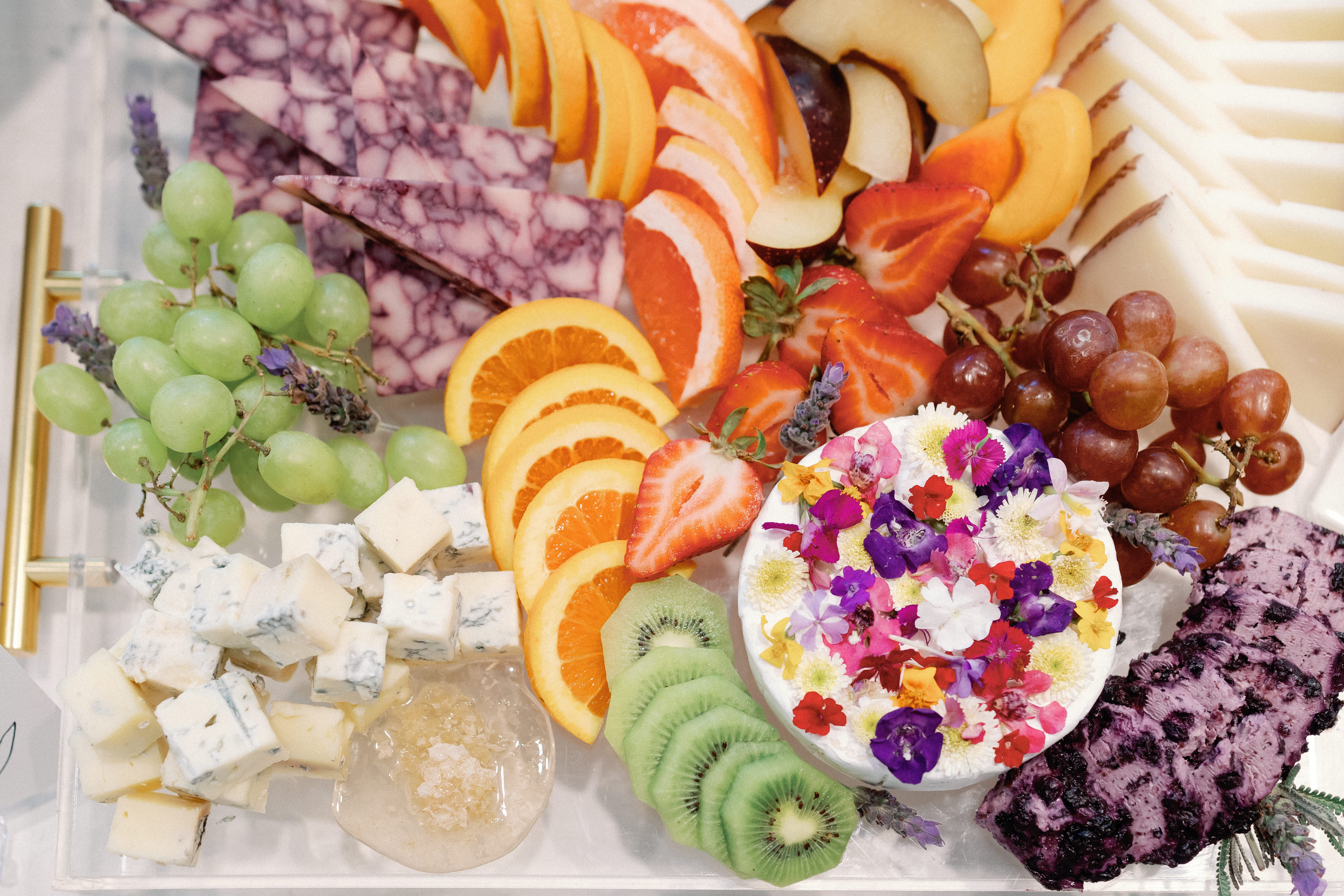
Summer fruit and cheese platter by Colette’s Catering & Events. Photo courtesy Lisette Gatliff
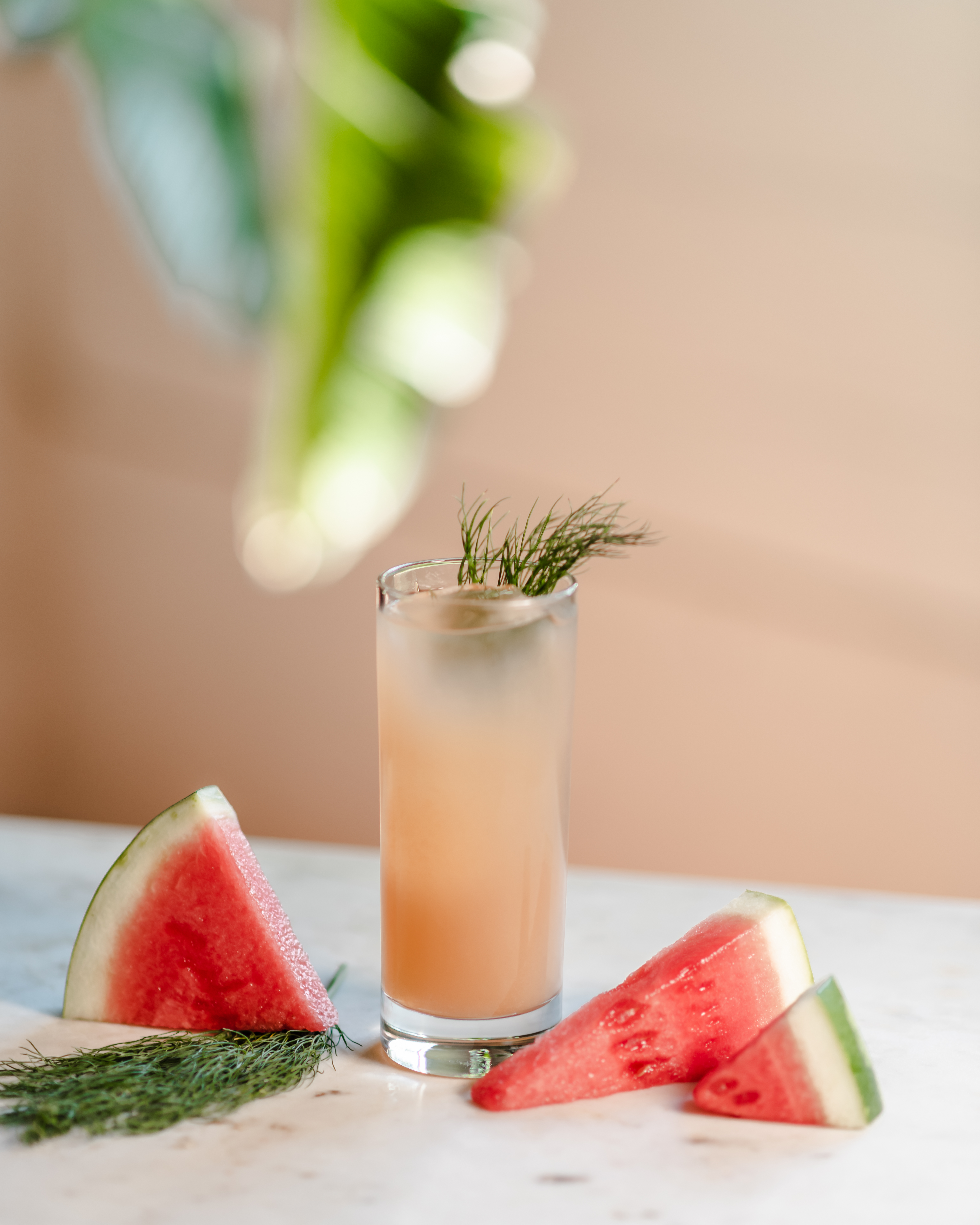
A watermelon-fennel shrub is both a refreshing beverage and a great way to serve what’s in season! Beverage by Chowgirls Catering. Photo courtesy Sage E Imagery
“For summer, I feel like it goes without saying that anything grilled” is ideal for Selden. “Peaches, heirloom tomatoes, fresh corn, and watermelon in salads or straight up as dessert all remind me of a great summer meal.” She also says of clients: “They tend to lean towards menus that often don’t even include a starch, as the veggies are so delicious and fresh at that time of year that they don’t miss the potatoes.”
Kuhlberg agrees that the right seasonal choices help balance the season’s heat. “When summer comes around, your menu can reflect that with cool choices like chilled tomato gazpacho, grilled seafood, and barbecue chicken.”
The fruity floral beverages of spring work for summer, too. “Summertime refreshments like tropical iced teas and lemonades and fruity margaritas are total winners. You can also bring in the summer vibes with classic mojitos and sangrias,” recommends Kuhlberg.
Fall
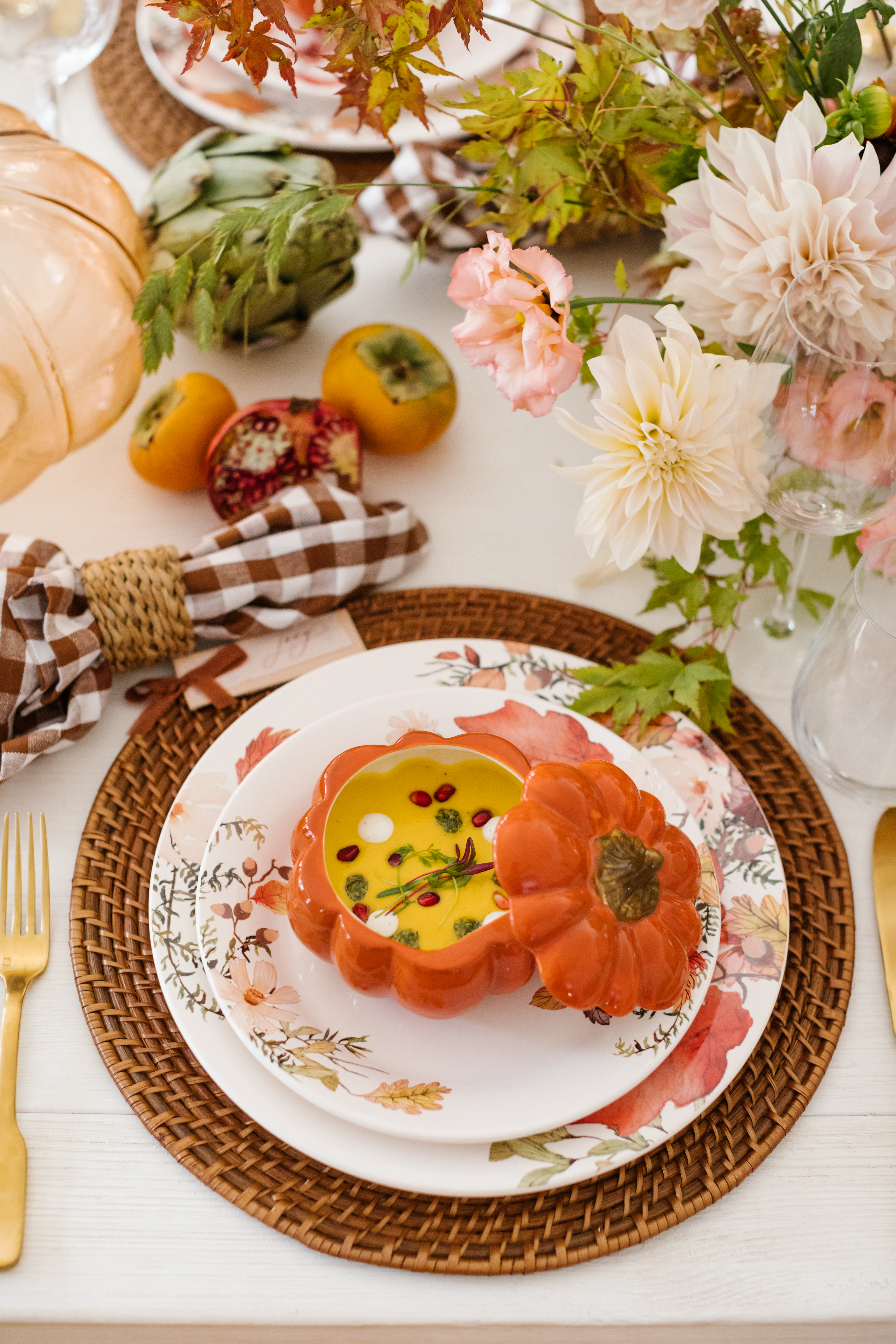
Spiced butternut squash soup with pepita pesto, lime crema, and pomegranate in ceramic pumpkin bowls by Colette’s Catering & Events. Photo courtesy Alison Berner
As the temperature cools off, cravings turn toward heavier meals and reflect the change in seasonal produce.
“Autumn is the time to celebrate the harvest season,” Kuhlberg reminds us. “Think about comforting pasta ragu, herbed turkey roasted to perfection, sweet potato gnocchi, and apple-cinnamon desserts that capture the essence of fall.”
Selden agrees. “I think of anything with apples, pumpkin, or butternut squash. I love our butternut squash crumble as a great hearty side dish for things like pork or turkey.”
Beverages this time of year become things of comfort as well.
“Again, in the fall—especially in the Northeast—I’d go back to the apples and say apple cider or mulled apple cider as it gets colder,” says Selden, “as well as mulled wine, which is so delish!”
Kuhlberg adds spiced chai to the list of comforting drinks. She adds: “Embrace the rich flavors of fall with apple brandy sidecars and Old Fashioned cocktails.”
Winter
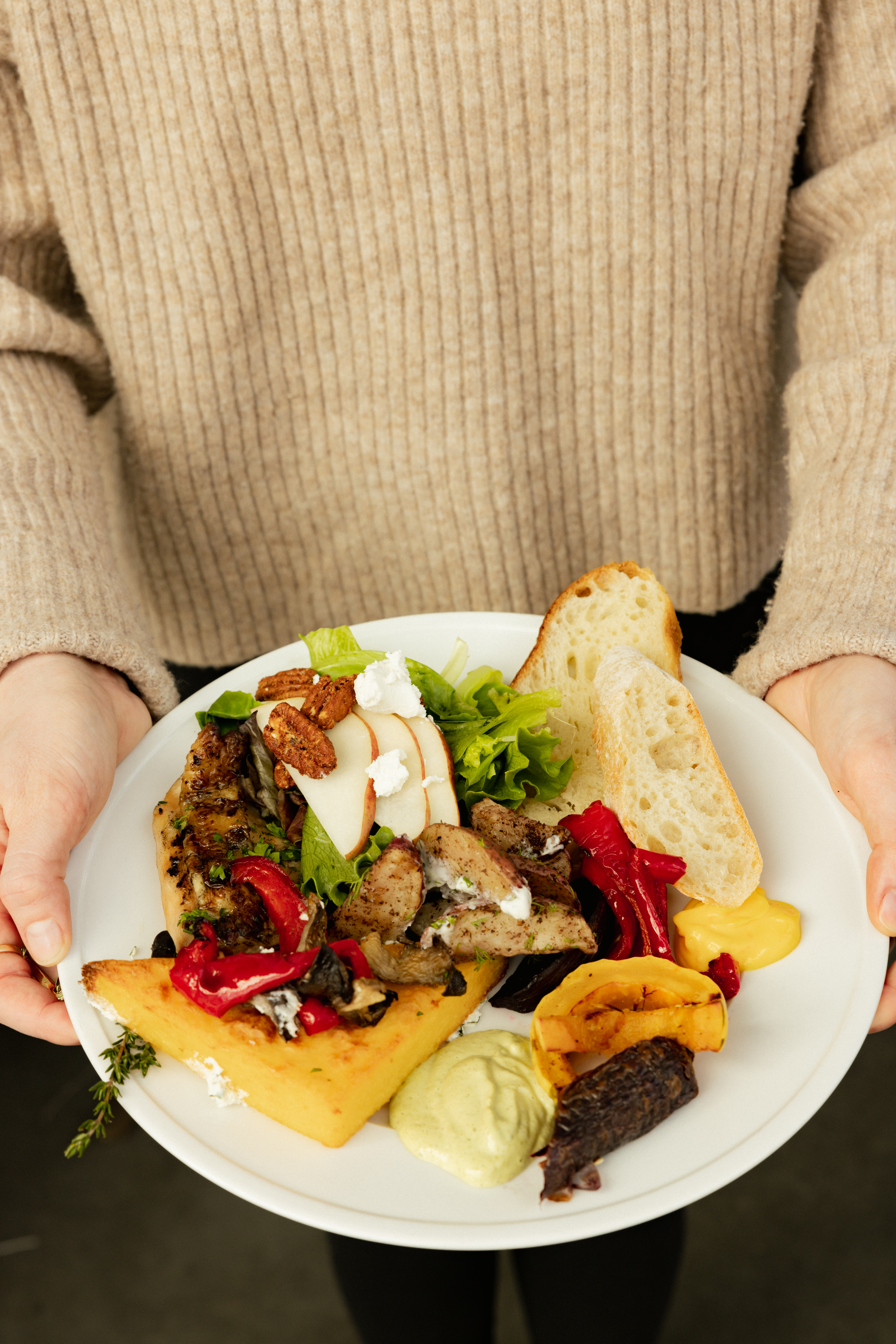
From mid-November to March in Minnesota, Chowgirls Catering pulls from in-season produce to make this winter family-style dinner. Photo courtesy Amy Diep
Winter is the time for the heartiest, warmest nostalgic flavors.
“As the weather in the Northeast gets cooler, I often turn to hearty soups or chili, as it is so comforting,” says Selden. “Our clients love braised, slow-roasted comfort foods in the fall and winter season, too.”
Kuhlberg recommends warming, grounding foods as well. “When the chill sets in for winter, think about hearty options like beef stew, winter squash soup that warms the soul, and those roasted meats that everyone loves. Don't forget those comforting sides like roasted root veggies, mashed potatoes, and rich, flavorful au jus.”
Winter beverages are also all about warming and heartiness. “When it's frosty outside, warm everyone up with classics like mulled wine, hot cocoa stations, and pomegranate martinis,” suggests Kuhlberg.
Don’t forget about holiday traditions, either. “Winter screams eggnog, especially around the holidays,” says Selden. “Anything with bourbon like a killer Old Fashioned always is a popular choice.”
An act of collaboration
Working with your caterer to create a menu that’s in season is beneficial not only to our world but to your brand—you can utilize this community and your place as a planner to portray yourself as an expert on the menu and as a high-quality event producer.
Using fresher, local food ingredients that are at their peak in nutrients and flavor will only reflect your ability to provide a quality dining experience for your clients and to keep up with the demand for local, sustainable dining. “Advise your clients that incorporating these ingredients enhances the overall dining experience. They can expect vibrant colors, better taste, and a connection to the time of year,” recommends Kuhlberg.
As a planner, you can use your network with knowledgeable caterers to portray yourself as an industry expert who is in touch with the nuances of the food system and as a provider of first-rate event production.
“When event planners collaborate with caterers on menu planning, understanding the principles of eating seasonally and creating seasonal menus can lead to effective communication with clients and a smoother planning process,” Kuhlberg continues.
Finding an educated caterer makes the selling process easier as well. “We work with several vendors that know Chowgirls well and they sell their clients on our expertise in events, quality, presentation, hospitality, and our respect for the planet,” says Heathcote-Curry. “If there are planners we haven’t had the opportunity to work with yet, we gladly educate them and their clients on our seasonal menus and sustainable practices!”
You don’t have to subject your clients (or yourself) to a college course’s worth of knowledge, however. In some ways, building the right relationships means your clients trust you and the caterer to create the best food for their event, regardless of how much they know about the seasons. In fact, Chowgirls makes sure to nurture relationships by hosting tasting events throughout the year, where they educate event planners and vendor partners on seasonality and showcase new menus.

When nurtured, the relationships between planners and caterers can lead to trust, communication, and smoother selling—a win-win situation! Photo courtesy Lucas Botz
Since these tastings often embrace different seasons than when they take place, they focus more on showcasing the flavor profiles and composition of the menu items rather than specific ingredients themselves. Special Events attended their most recent tasting, a winter holiday menu reveal that took place in August. While some dishes contained summer produce, the catering company used the event to introduce new menu offerings and build relationships while demonstrating the quality of the food, regardless of the seasonal produce featured.
“Our menus are very transparent, highlighting the ingredients that are available in that season,” says Heathcote-Curry. “We find when we give examples of what this menu item has featured in that season, most clients don’t mind not knowing the exact ingredients! We love that our clients trust us in our quality and presentation, and the majority love learning about our efforts as a sustainable company. We always ask clients if there are any food allergies or dietary preferences so we make sure to avoid sending them a seasonal ingredient they don’t like or can’t eat.”
Whether you are working with your favorite caterers or with a venue that has a preferred caterer, begin by asking questions and having a conversation to learn how they source their ingredients and whether they stick with what is in season or if they transport out-of-season food items from different climates. Once you know how they work, you can begin either learning more about their sourcing and work with them to better sell in-season menus to clients, or if they don’t already practice this seasonality, discern whether they are open to learning, or else seek out caterers who value this approach.
“My best piece of advice is to bring the catering partner in for the conversations regarding the menu,” says Selden. “Even go as far to let them lead that conversation and really take the time to get to know the client, understand what they love, the restaurants that they enjoy, the places that they travel, get to know their favorite (and least favorite) foods so that when they provide a proposal, they are able to customize the menu to suit the client and also to represent their brand well.”
This is where collaboration is key: as planner, you have a lot of information that can assist in these conversations. In her keynote speech at Catersource + The Special Event this past March, event pro Marcy Blum (Marcy Blum Associates) told the crowd, “We are the gatekeepers. We are able to give [the caterer] clues and tricks and insight they wouldn’t get otherwise; I can upsell things so much easier to a client because I’ve basically been living with them.” When both you and your catering team are on the same page and understand the client well, the menu will come together smoothly.
“By familiarizing themselves with the benefits and considerations of seasonal menus, event planners can effectively communicate the advantages to their clients,” Kuhlberg emphasizes. “Collaborating closely with caterers ensures that the culinary aspect of the event is aligned with the overall vision, resulting in a memorable and satisfying experience for all involved.”
Bonus: A Touch of Seasonal Décor
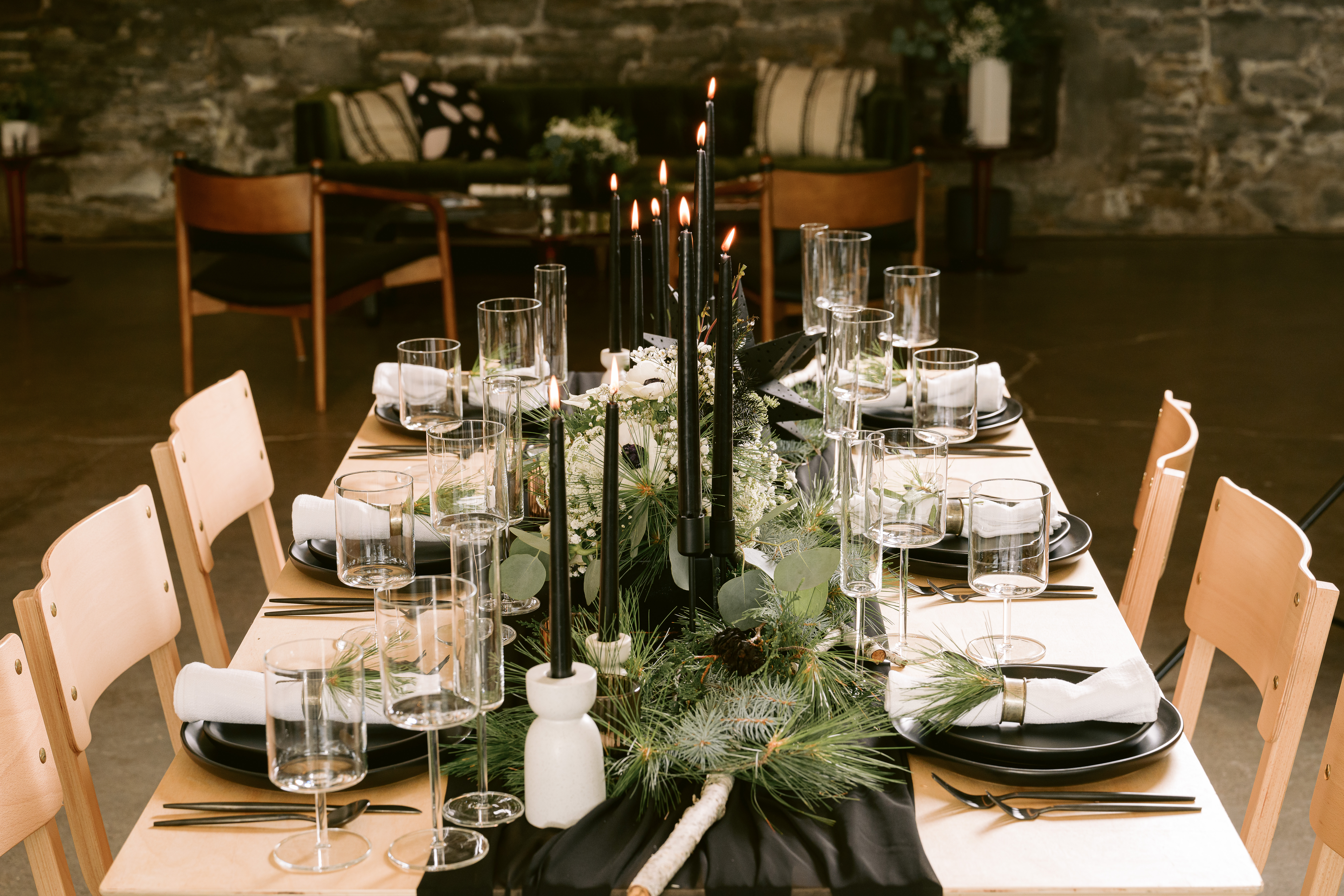
A winter-inspired tablescape by Chowgirls Catering, using evergreen and birch branches. Chowgirls’ winter menu runs from November through March. Photo courtesy Lucas Botz
There are ways to use the seasons to your advantage in decorating as well—ways that don’t necessarily have to be “season-themed.”
One of the easiest ways to do this is to use florals that are in season (which comes down to whatever is in season in your event’s location). By working with flowers and greenery that are at their peak, you can channel seasonal sentiment, work with local suppliers and cheaper prices, and create a sense of connection to nature. For example, use greens and bulb flowers like daffodils and tulips in spring, or evergreen branches and poinsettias in winter. Your event doesn’t need to be fall-themed but can certainly use colorful leaves and asters to enliven the event space.
Use colors that are found out your window for menus, chargers, and linens. Even the stationery can replicate plants that are in season through the use of illustrations and dried florals.
Another way to embrace the seasons is to use scented candles or incense that reflects the time of year. Nature can be one of the best sources of inspiration for planners!

